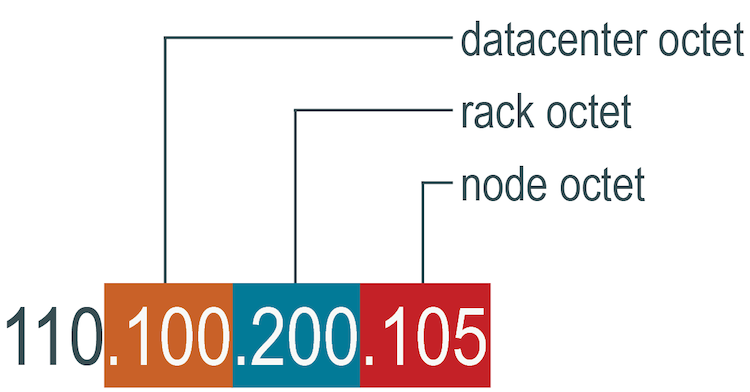Types of snitches
Overview of the snitches available in DataStax Enterprise.
cassandra-topology.properties
The location of the cassandra-topology.properties file depends on the type of installation:| Package installations | /etc/dse/cassandra/cassandra-topology.properties |
| Tarball installation | installation_location/resources/cassandra/conf/cassandra-topology.properties |
cassandra-rackdc.properties
The location of the cassandra-rackdc.properties file depends on the type of installation:| Package installations | /etc/dse/cassandra/cassandra-rackdc.properties |
| Tarball installations | installation_location/resources/cassandra/conf/cassandra-rackdc.properties |
DataStax Enterprise (DSE) provides the following types of snitches:
- DseSimpleSnitch (default)
- Use this snitch only for development deployments. This snitch does not recognize datacenter or rack information. When using this snitch, define the keyspace to use SimpleStrategy and specify a replication factor.
- GossipingPropertyFileSnitch
- This snitch is recommended for production. It uses rack and datacenter information for the local node defined in the cassandra-rackdc.properties file and propagates this information to other nodes via gossip. To configure, see .
- Ec2Snitch
- Use this snitch for simple cluster deployments on Amazon EC2 where all nodes in the cluster are within a single region.
- Ec2MultiRegionSnitch
- Use this snitch for deployments on Amazon EC2 where the cluster spans multiple regions.
- GoogleCloudSnitch
- Use this snitch for DSE deployments on Google Cloud Platform across one or more regions. The region is treated as a datacenter, and the availability zones are treated as racks within the datacenter. All communication occurs over private IP addresses within the same logical network. To configure, see .
- CloudstackSnitch
- Use this snitch for Apache Cloudstack environments. Because zone naming is free-form
in Apache Cloudstack, this snitch uses the
<country> <location> <az>notation. To configure, see CloudstackSnitch. - PropertyFileSnitch
- This snitch determines proximity as determined by rack and datacenter. It uses the network details located in the cassandra-topology.properties file. When using this snitch, define datacenter names using a standard convention, and make sure that the datacenter names correlate to the name of your datacenters in the keyspace definition. Every node in the cluster should be described in the cassandra-topology.properties file, which must be exactly the same on every node in the cluster.
- RackInferringSnitch
- This snitch determines the proximity of nodes by datacenter and rack, which are assumed
to correspond to the second and third octet of the node's IP address, respectively. It is
best used as an example for writing a custom snitch class (unless this format happens to
match your deployment conventions).
Figure 1. 
